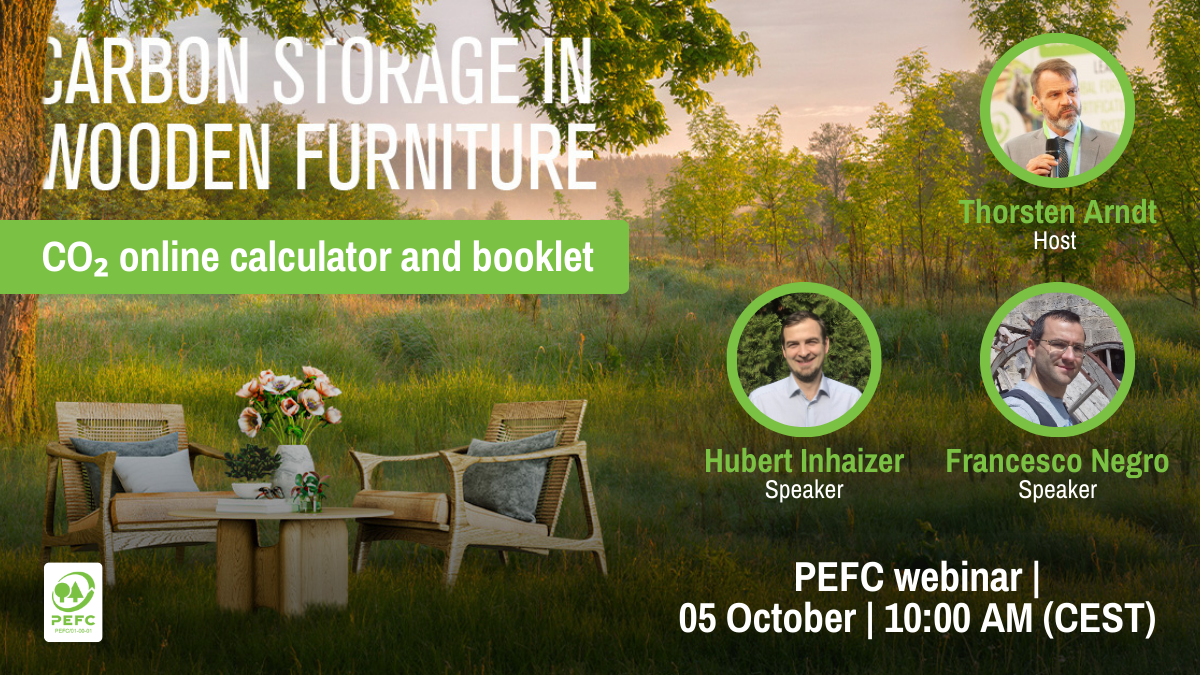Carbon Storage in Wooden Furniture - Living in a Sustainable World
By producing and procuring sustainably sourced wooden furniture, you support practices that help mitigate climate change. Discover how PEFC can help you enhance your contribution.
Carbon Storage in Wooden Furniture - Living in a Sustainable World
5 October 2023 Webinar
How does wooden furniture store carbon and what difference does sustainable forest management make? Do you want to know how you can calculate the quantity of carbon you’ve removed from the atmosphere through your responsible furniture choices?
Scroll down and learn more or click here to access our free "Carbon Storage Calculator"

You’ll discover all the answers in our upcoming webinar this October. Our experts will demonstrate how sustainably managed forests sequester carbon dioxide (CO2) differently from unmanaged forests and approximately how much carbon wooden furniture can sequester from the atmosphere.
Additionally, we will also introduce the carbon storage in wooden furniture booklet and calculator to support companies in calculating the amount of CO2 sequestered in their wooden furniture.
This resource and the webinar in general will provide a clearer picture of how our individual actions and consumption habits impact the level of greenhouse gases in the atmosphere.
Our speakers are professionals with extensive, hands-on experience in the field. You will hear from Hubert Inhaizer, a forest owner himself, and PEFC International’s expert on sustainable forest management. In addition, we welcome Francesco Negro, Associate Professor in Wood Technology, University of Torino, Italy, to provide his insights into how the carbon storage booklet and calculator can support you.
Agenda
- 5 mins - Thorsten Arndt opens the webinar with a brief introduction to PEFC
- 10 mins - Hubert Inhaizer on how certification supports carbon storage in forests
- 30 mins - Francesco Negro introduces the Carbon Storage in Wooden Furniture Booklet and Calculator
- 30 mins - Panel discussion and Q&A
Carbon Storage in Wooden Furniture
Why are we focusing our attention on carbon dioxide?
The world faces an urgent and daunting crisis: climate change. Global warming is the engine of the undergoing climate crisis, whose effects are well known, from droughts and extreme heat, to floods, ice melt, and intense atmospheric events. .
Carbon dioxide is widely considered the most impactful of the greenhouse gases because of its abundance in the atmosphere, high global warming potential, and status as the primary gas emitted through human activities. CO2 plays such a critical role in global warming that all greenhouse gases are now commonly measured and expressed as CO2 equivalents (CO2e). Reducing CO2 emissions and finding strategies to sequester it from the atmosphere is imperative to address and mitigate the climate crisis.
The race to net zero
In 2015, over 190 countries united to negotiate and sign the Paris Agreement at the United Nations Climate Change conference. This historic accord demanded global CO2 emissions to be slashed by at least 43% by 2030, with the goal of achieving net-zero carbon output by 2050. However, as we approach COP28 in Dubai, a crucial global 'stocktake' is expected to reveal the inadequacy of our advancements towards meeting those critical goals.
Forests lie at the core of humanity's battle against climate change, making them indispensable for achieving our global climate goals. Forests serve as our second most significant carbon sinks after the world’s oceans, effectively removing approximately 19% of global greenhouse gas emissions through carbon sequestration, storage, and substitution in trees and soil. Nevertheless, the key lies in their sustainable management.
Sustainable forest management maximizes the capacity of forests to capture and store carbon

When forests are managed sustainably, their potential to capture and store carbon is maximized. PEFC’s Sustainable Forest Management practices promote forest health and vitality through ecosystem rehabilitation, biodiversity preservation, and pest and climate damage monitoring. This includes maintaining a balance between tree harvesting and regrowth, which helps to preserve carbon stocks and enhance the capacity of trees to capture and store carbon in the medium and long term.
Additionally, sustainably managed forests offer a renewable resource in the form of wood and timber, which continue to store carbon long after harvesting. The PEFC-certified wooden furniture you produce, buy, and sell is storing carbon and will continue to do so for the lifetime of the product.
The furniture industry can make a significant impact in tackling the climate crisis.
As a major user of wood, the furniture industry can play a significant role in our efforts to remove, capture, and store carbon from the atmosphere at a meaningful scale. With the demand for wood set to rise by 37% by 2050, the furniture industry must take action.
It's crucial to develop a plan to measure and reduce the industry’s carbon footprint in response to the ongoing climate crisis. By doing so, the furniture industry can play a vital role in meeting and even surpassing our collective climate goals.
With these facts in mind, PEFC has developed a booklet and calculator for carbon storage in wooden furniture. This tool will help furniture industry companies, stakeholders, and consumers accurately measure the carbon storage potential of the wooden furniture they purchase, produce, or sell.
The furniture industry will have a critical role to play in mitigating the climate crisis and this resource will form an essential link in the effort towards reducing the carbon footprint of the furnishings industry at scale.